Scientific name Canis aureus Size of territory 2 – 4 km² (Serengeti) | Phylum Chordata Suborder Caniformia Genus Canis Higher classification Canis Rank Species | |
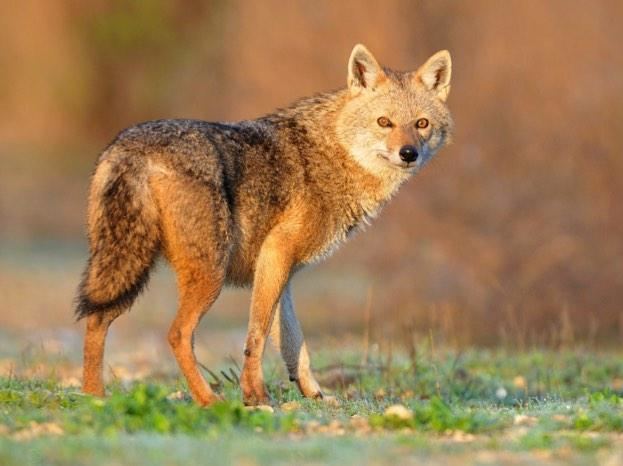 | ||
Similar Gray wolf, Canis, Black‑backed jackal, Mammal, Canidae | ||
The golden jackal (Canis aureus) is a canid native to southeastern and central Europe, Asia Minor, the Middle East and South Asia. It is listed as Least Concern on the IUCN Red List, due to its widespread range in areas with optimum food and shelter. It is a social species, the basic social unit of which consists of a breeding pair and any offspring it might have. The golden jackal is very adaptable, being able to exploit many foodstuffs, from fruit and insects to small ungulates. As of 2005, MSW3 recognises 13 subspecies, though genetic studies published in 2015 revealed that six supposed golden jackal subspecies living in Africa were members of a separate species, Canis anthus, reducing the number of actual golden jackal subspecies to seven.
Contents
- Calling golden jackal with nordik predator pre tuned
- Etymology
- Physical description
- Taxonomy and evolution
- Subspecies
- Behaviour
- Reproduction and development
- Denning and sheltering
- Hunting and feeding
- Habitat
- Diet
- Enemies and competitors
- Range and conservation
- Diseases and parasites
- In folklore mythology and literature
- Livestock game and crop predation
- Hunting
- Fur use
- In captivity
- Attacks on humans
- References
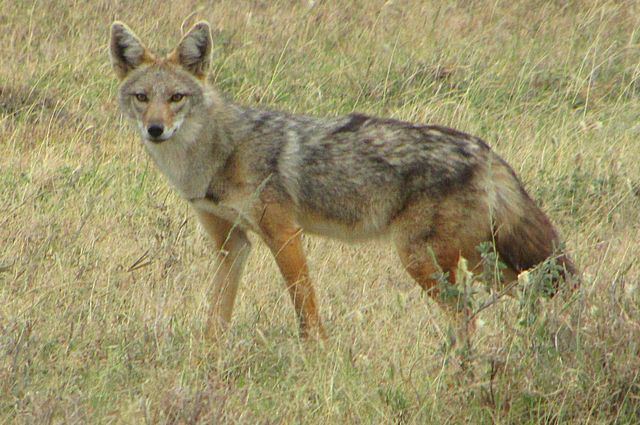
Although similar to a small grey wolf, the golden jackal is distinguished by a more slender build, a narrower, more pointed muzzle, a shorter tail, and a lighter tread. Its winter fur also differs from a wolf's by its more fulvous-reddish colour. Despite its name, the golden jackal is not closely related to black-backed or side-striped jackals, being instead more closely related to grey wolves, coyotes, and Ethiopian wolves. It is capable of producing fertile hybrids with both grey and African wolves.
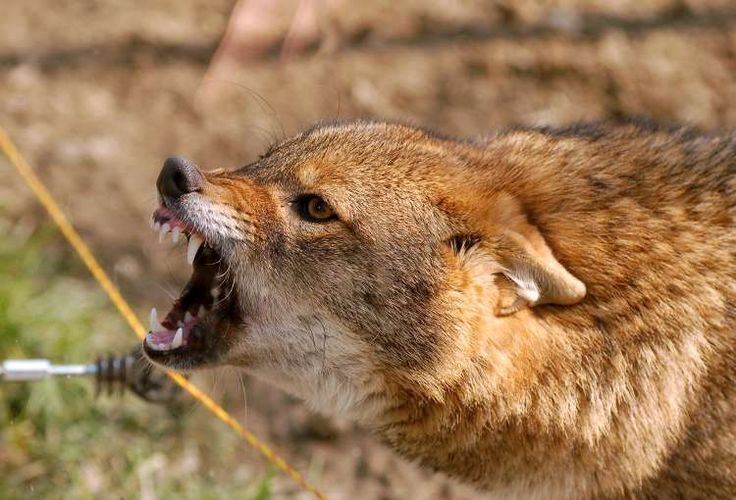
Golden jackals feature prominently in Middle-Eastern and Asian folklore and literature, where they are often described as tricksters analogous to the fox and coyote for European and North American tales, respectively. In contrast, in Europe it is largely viewed in a negative light as a filthy scavenger, whose presence is indicative of environmental degradation.
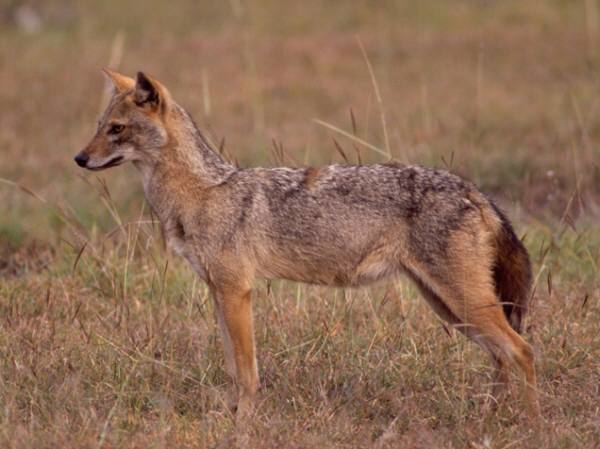
Calling golden jackal with nordik predator pre tuned
Etymology
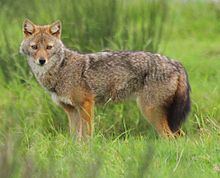
The word "jackal" first appeared in English around 1600, and is derived from the French chacal, itself ultimately traceable to the Sanskrit srgala-s, which means "the howler."
Other names for the species include Eurasian golden jackal, common jackal, Asiatic jackal or reed wolf.
Physical description
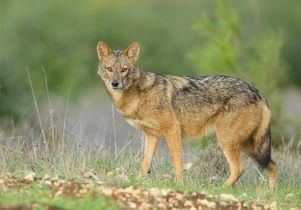
The golden jackal is very similar to the grey wolf in general appearance, but is distinguished by its smaller size, lighter weight, shorter legs, more elongated torso and shorter tail. The end of the tail just reaches the heel or slightly below it. The head is lighter than the wolf's, with a less-prominent forehead, and the muzzle is narrower and more pointed. Males measure 71–85 cm in body length, with females being somewhat smaller. It stands 44.5–50 cm in shoulder height, and weighs around 6–14 kg (13–31 lbs).
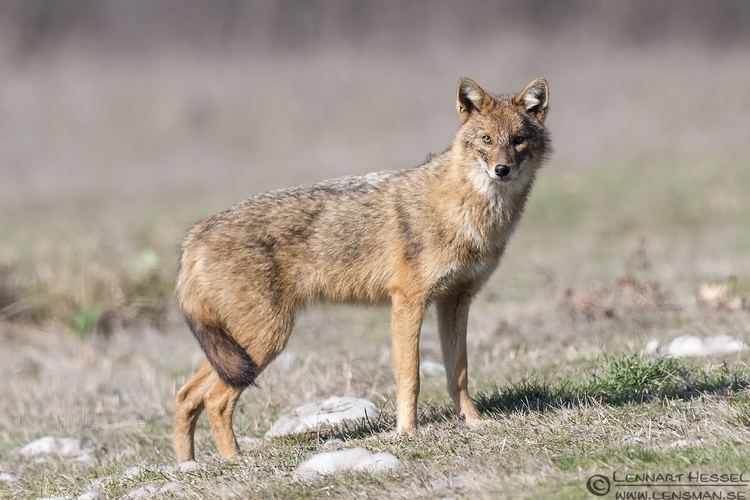
Its skull is similar to the wolf's, but is smaller and less massive, with a lower nasal region and shorter facial region. The projections of the skull are strongly developed, but weaker than the wolf's. Its canine teeth are large and strong, but relatively thinner than the wolf's, and its carnassials are weaker. Occasionally, it develops a horny growth on the skull, which is associated with magical powers in southeastern Asia. This horn usually measures half an inch in length, and is concealed by fur. The iris is light or dark brownish. Females have 5 pairs of teats.
The fur's base colour is golden, though this varies seasonally from pale creamy yellow to dark tawny. The fur on the back often consists of a mixture of black, brown and white hairs, which sometimes form a dark saddle similar to the black-backed jackal's. Animals from high elevations tend to have buffier coats than their lowland counterparts. The underparts and belly are of a lighter pale ginger to cream colour than the back. Individual specimens can usually be distinguished by light markings on the throat and chest which differ individually. The tail is bushy, and has a tan or black tip.
Melanism occasionally occurs, and was once considered "by no means rare" in Bengal. Unlike melanistic wolves and coyotes, which historically received their dark pigmentation from interbreeding with domestic dogs, melanism in golden jackals likely stems from an independent mutation, and could be an adaptive trait. An albino specimen was photographed in 2012 in southeastern Iran.
The golden jackal moults twice a year, in spring and autumn. In Transcaucasia and Tajikistan, the spring moult begins during mid-late February, while during winter it starts mid-March and ends mid-late May. In healthy specimens, the moult lasts 60–65 days. The spring moult begins on the head and limbs, then extends to the flanks, chest, belly and rump, with the tail coming last. The autumn moult occurs from mid-September onward. The shedding of the summer fur and the growth of the winter coat is simultaneous. The development of the autumn coat starts with the rump and tail, spreading to the back, flanks, belly, chest, limbs and head, with full winter fur being attained at the end of November.
Taxonomy and evolution
The golden jackal is scantily represented in the fossil record, and its direct ancestor is unknown; two previous candidates, Canis kuruksaensis and C. arnensis (from Villafranchian Tajikistan and Italy respectively), were demonstrated to be related more closely to coyotes than the jackals. Jackal-like fossils appear in South Africa as late as the Early Pleistocene, though remains identifiable as the golden jackal only appear beginning with the Middle Pleistocene. The absence of jackal fossils in the Caucasus region and Transcaucasia, areas where the species currently resides, indicates that the species is a relatively recent arrival in those places. However, its presence in the Balkan peninsula is probably quite ancient, as fossil finds in Croatia indicate that the species has been established in the Dalmatian Coast since the Late Pleistocene or early Holocene. Jackals likely entered the Balkans during the last glacial maximum via a land bridge across the current Bosphorus strait.
According to Juliet Clutton-Brock, golden jackals are the "most typical" members of the genus Canis, being of medium size and not having any outstanding features. Though less basal than the black-backed and side-striped jackals, it is nonetheless a somewhat less specialised species than the grey wolf, as indicated by its relatively short facial region, weaker tooth row and the more weakly developed projections of the skull. These features are related to the jackal's diet of small birds, rodents, small vertebrates, insects and carrion. The characteristics of the golden jackal's skull and genetic composition indicate a closer affinity to the grey wolf and coyote than to the black-backed and side-striped jackal.
Studies on mitochondrial genome sequences and whole genome nuclear sequences of African and Eurasian golden jackals showed that that the African specimens represented a distinct monophyletic lineage that should be recognized as a separate species, Canis anthus (African golden wolf), and that any superficial similarity between the two was due to parallel evolution. According to a phylogeny derived from nuclear sequences, the African golden wolf separated from the wolf/coyote clade 1.3 million years ago, while the Eurasian golden jackal, Canis aureus diverged 1.9 million years ago and is more distant from these species than is the Ethiopian wolf, as shown below:
Genetic analysis of microsatellite and mitochondrial DNA showed that showed that European jackals have much lower haplotype diversity than those in Israel (where they have admixed with dogs, grey wolves and African wolves), and that they mostly descend from populations originating from the Caucasus. The highest level of haplotype diversity was found in Peloponnesian jackals, which may represent a relict population of Europe's original golden jackals prior to their extirpation elsewhere. Particular attention was paid to the genetics of Baltic jackals, as all Baltic states class the animal as an artificially introduced invasive species subject to extermination. It was found that jackals in Estonia originate from the south-eastern European population, whereas those in Lithuania are of Caucasian origin; this was concluded to render the hypothesis of an artificial introduction unlikely, and that their presence in both states was consistent with the natural northward expansion of both southeastern and eastern European populations.
In captivity, golden jackals are capable of hybridising with coyotes, though such hybrids become infertile at the second generation. In contrast, the golden jackal seems to have unlimited fertility with dogs and wolves. Because of Egypt's contiguity with Israel, traces of African golden wolf DNA were identified in Israeli golden jackals, thus indicating the presence of a hybrid zone.
Subspecies
Because of the species' wide distribution, a large number of local races have been described, though it remains poorly understood in terms of genetics; while the karyotype of Croatian jackals is similar to that of dogs and wolves (2n = 78; NF = 84), that of Indian jackals differs considerably (NF = 80), resulting in the possibility that the golden jackal is in fact an aggregate of poorly defined species.
As of 2005, 13 subspecies of golden jackal were recognised by MSW3. However, a genomic study published during 2015 found that all African taxa previously assigned to C. aureus are more closely related to the grey wolf than they are to the other golden jackal subspecies, with a genetic divergence of around 6.7%. The six African subspecies populations were thus reclassified as African golden wolves (C. anthus), thus reducing the actual number of golden jackal subspecies to seven.
Behaviour
The golden jackal is flexible in its sociability, living either alone or in family groups of 4–5 individuals. The vocalisations of the golden jackal are similar to those of the domestic dog, though more "plaintive". Its howl consists of a wailing "Ai-yai! Ai-yai!" sound, with a variant having been transcribed as "Dead Hindoo, where, where, where?". Adults howl standing, while young or subordinate specimens do so in a sitting posture, with the frequency of howling increasing during the mating season. The golden jackal has been recorded to howl upon hearing church bells, sirens or the whistles of steam engines and boats. It typically howls at dawn, midday and the evening. When in the vicinity of tigers, leopards or any other cause for alarm, the golden jackal emits a cry that has been variously transliterated as "pheal", "phion" or "phnew". When hunting in a pack, the dominant jackal initiates an attack by repeatedly emitting a sound transliterated as "okkay!". Compared to young wolves and dogs, golden jackal pups are much more aggressive and less playful with one another, with interactions frequently escalating into uninhibited fighting.
Reproduction and development
Golden jackals are monogamous, with remarkably long courtship periods lasting 26–28 days. In Transcaucasia, estrus begins during early February, or occasionally late January during warm winters. Spermatogenesis in males occurs 10–12 days before the females enter estrus, which lasts for 3–4 days. Females failing to mate during this time will undergo a loss of receptivity which lasts six to eight days.
Females undergoing their first estrus are often pursued by several males, which may quarrel amongst themselves. Once a male is selected, he proceeds to lick the female's vulva, and repeatedly mounts her without erection or hip thrusting. Actual copulations begin days later, and continue for about a week. Copulation itself lasts 20–45 minutes.
In Transcaucasia, pups are usually born from late March to late April, and in northeastern Italy probably during late April, though they are born at any time of year in Nepal. The number of pups in a single litter varies geographically; jackals in Uzbekistan give birth to 2–8 pups, in Bulgaria 4–7, in Michurinsk only 3–5, and in India the average is four. Pups are born with shut eyelids and soft fur, which ranges in colour from light grey to dark brown. At the age of one month, their fur is shed and replaced with a new reddish coloured pelt with black speckles. Their eyes typically open after 8–11 days, with the ears erecting after 10–13 days. The eruption of adult dentition is completed after five months. The pups have a fast growth rate; at the age of two days, they weigh 201–214 g, 560–726 g at one month, and 2700–3250 g at four months.
The length of the nursing period varies; in the Caucasus it lasts 50–70 days, while in Tajikistan it lasts as long as 90 days. The lactation period ends typically during mid-July, though in some areas it ends during early August. The pups begin to eat solid food at the age of 15–20 days. Once the lactation period concludes, the female drives off the pups. Pups born late remain with their mother until early autumn, at which time they leave either singly or in groups of two to four individuals.
Denning and sheltering
In the Caucasus and Transcaucasia, female golden jackals usually give birth in burrows dug with the assistance of males, or they occupy derelict fox or badger dens. The burrow is dug a few days before parturition, with both the male and female taking turns digging. The burrow is located either in thick shrubs, on the slopes of gulleys or on flat surfaces. A golden jackal burrow is a simple structure with a single opening. Its length is about 2 metres, while the nest chamber occurs at a depth of 1.0–1.4 metres. In Dagestan and Azerbaijan, litters are sometimes located within the hollows of fallen trees, tree roots and under stones on river banks. In Middle Asia, the golden jackal does not dig burrows, but constructs lairs in dense tugai thickets. Jackals in the Vakhsh tugais construct 3-metre-long burrows under tree roots or directly in dense thickets. Jackals in the tugais and cultivated lands of Tajikistan construct lairs in long grass plumes, shrubs and reed openings.
Hunting and feeding
The golden jackal rarely hunts in groups, though packs of 8–12 jackals consisting of more than one family have been observed in the summer periods in Transcaucasia. When hunting alone, the golden jackal will trot around an area, occasionally stopping to sniff and listen. Once prey is located, it will conceal itself, quickly approach, then pounce. When hunting in pairs or packs, jackals run parallel to their prey and overtake it in unison. When hunting aquatic rodents or birds, they will run along both sides of narrow rivers or streams, driving their prey from one jackal to another.
Habitat
The golden jackal is a generalist that adapts to local food abundances, a trait which allows it to occupy a variety of different habitats and exploit a large number of food resources. Its lithe body and long legs allows it to trot for large distances in search of food. It has the ability to forego liquids, and has been observed on islands with no fresh water. It can survive in temperatures as low as −25° or −35°, though it is not maximally adapted for living in snowy areas. Its preferred habitats consist of flat shrublands, humid reeded areas and floodplains. Although it generally avoids mountainous forests, it may enter alpine and subalpine areas during dispersal. In Turkey, Caucasus and Transcaucasia, it has been observed at heights of up to 1,000 meters above mean sea level (MAMSL), particularly in areas where the climate forces shrublands into high elevations.
Diet
The golden jackal is an omnivorous and opportunistic forager; its diet varies according to season and habitat. In Bharatpur, India, over 60% of its diet consists of rodents, birds and fruit, while 80% of its diet consists of rodents, reptiles and fruit in Kanha. In the Caucasus and Transcaucasia, golden jackals primarily hunt hares and mouse-like rodents, as well as pheasants, francolins, ducks, coots, moorhens and passerines.
Vegetable matter eaten by jackals in these areas includes fruits, such as pears, hawthorn, dogwood and the cones of common medlars. It is implicated in the destruction of grapes, watermelons, muskmelons and nuts. Near the Vakhsh River, the jackal's spring diet consists almost exclusively of plant bulbs and the roots of wild sugar cane, while during winters it feeds on the fruit stones of wild stony olives. In the edges of the Karakum Desert, the golden jackal feeds on gerbils, lizards, snakes, fish and muskrats. Karakum jackals also eat the fruits of wild stony olives, mulberry and dried apricots, as well as watermelons, muskmelons, tomatoes and grapes. In Hungary, its most frequent prey animals are common voles and bank voles. Information on the diet of the golden jackal in northeastern Italy is scant, but it certainly preys on small roe deer and hares.
In Dalmatia, mammals (the majority being even-toed ungulates and lagomorphs) comprised 50.3% of the golden jackal's diet, fruit seeds (14% each being common fig and common grape vine, while 4.6% are Juniperus oxycedrus) and vegetables 34.1%, insects (16% orthopteras, 12% beetles, and 3% dictyopteras) 29.5%, birds and their eggs 24.8%, artificial food 24%, and branches, leaves, and grass 24%.
In Israel, golden jackals have been shown to be significant predators of snakes, including venomous snakes; an increase of snakebites occurred during a period of a poisoning campaign against golden jackals while a decrease in snakebites occurred when the poisoning ceased.
Enemies and competitors
Golden jackals tend to dominate smaller canid species. In Israel, red foxes will avoid close physical proximity with jackals, with studies showing that fox populations decrease where jackals are abundant. Conversely, jackals vacate areas inhabited by wolves, which have been known to approach jackal-calling stations at a quick trotting pace, presumably to chase them away.
The jackal's recent expansion throughout eastern and western Europe has been attributed to historical decreases of wolf populations. The present diffusion of the golden jackal in the northern Adriatic hinterland seems to be in rapid expansion in various areas where the wolf is absent or very rare. However, some jackals have been observed to follow and feed alongside wolves without evoking any hostility. In South-eastern Asia, golden jackals have been known to hunt alongside dhole packs.
In India, lone jackals expelled from their pack have been known to form commensal relationships with tigers. These solitary jackals, known as kol-bahl, will associate themselves with a particular tiger, trailing it at a safe distance to feed on the big cat's kills. A kol-bahl will even alert a tiger to a kill with a loud pheal. Tigers have been known to tolerate these jackals, with one report describing how a jackal confidently walked in and out between three tigers walking together a few feet away from each other.
Striped hyenas have been known to prey on golden jackals.
Range and conservation
The jackal's current European range mostly encompasses the Balkan region, where habitat loss and mass poisoning caused it to become extinct in many areas during the 1960s, with core populations only occurring in scattered regions such as Strandja, the Dalmatian Coast, Aegean Macedonia and the Peloponnese. It recolonised its former territories in Bulgaria during 1962, following legislative protection, and subsequently expanded its range into Romania and Serbia. Individual jackals further expanded into Italy, Slovenia, Austria, Hungary and Slovakia during the 1980s, with further range expansion in the Czech Republic, Estonia, Denmark, Poland and the Netherlands occurring during the 1990s–2010s. Jackal populations in Albania however are on the verge of extinction with possible occurrence in only three lowland wetland locations along the Adriatic Sea. The golden jackal is listed as an Annex V species in the EU Habitats Directive and as such has legal protection in Estonia, Greece and all other EU member states.
To the east, its range is through Turkey, Syria, Iraq, Iran, Central Asia, the entire Indian subcontinent, then east and south to Sri Lanka, Myanmar, Thailand and parts of Indochina. In India, the golden jackal is included in CITES Appendix III, and is featured in Schedule III of the Wildlife Protection Act, 1972, thus receiving legal protection, albeit at the lowest level. The species occurs in all of India's protected areas, save for those in the higher areas of the Himalayas.
Diseases and parasites
The golden jackal can carry diseases and parasites harmful to human health, including rabies and Donovan's Leishmania (which, although harmless to jackals, can cause leishmaniasis in people).
Jackals in southwestern Tajikistan have been recorded to carry 16 species of parasitic cestodes, roundworms and acanthocephalans, these being Sparganum mansoni, Diphyllobothrium mansonoides, Taenia hydatigena, T. pisiformis, T. ovis, Hydatigera taeniaeformis, Diphylidium caninum, Mesocestoides lineatus, Ancylostoma caninum, Uncinaria stenocephala, Dioctophyma renale, Toxocara canis, Toxascaris leonina, Dracunculus medinensis, Filariata and Macracanthorhynchus catulinum. Jackals infected with D. medinensis can infect water bodies with their eggs, and cause dracunculiasis in people who drink from them. Jackals may also play a large part in spreading coenurosis in sheep and cattle, and canine distemper in dogs. During July 2006, a jackal in Romania was found to be carrying Trichinella britovi. Jackals consuming fish and molluscs can be infected with metagonimiasis, which was recently diagnosed in a male jackal from northeastern Italy.
In Tajikistan, golden jackals carry at least 12 tick species (which include Ixodes, Rhipicephalus turanicus, R. leporis, R. rossicus, R. sanguineus, R. pumilio, R. schulzei, Hyalomma anatolicum, H. scupense and H. asiaticum), four flea species (Pulex irritans, Xenopsylla nesokiae, Ctenocephanlides canis and C. felis) and one species of louse (Trichodectes canis). In northeastern Italy, the species is a carrier of the tick species Ixodes ricinus and Dermacentor reticulatus.
In folklore, mythology and literature
Golden jackals appear prominently in Indian folklore and ancient texts, such as the Jakatas and Panchatantra, where they are often portrayed as intelligent and wily creatures. One popular Indian saying describes the jackal as "the sharpest among beasts, the crow among birds, and the barber among men". To hear a jackal howl when embarking on an early morning journey was considered to be a sign of impending good fortune, as was seeing a jackal crossing a road from the left. In Hinduism, the golden jackal is portrayed as the familiar of several deities, the most common of which being Chamunda, the emaciated, devouring goddess of the cremation grounds. Another deity associated with jackals is Kali, who inhabits the cremation ground and is surrounded by millions of jackals. According to the Tantrasara, when offered animal flesh, Kali appears before the officiant in the form of a jackal. The goddess Shivatudi is depicted with a jackal's head. According to the flood myth of the Kamar people of Raipur, God caused a deluge to dispose of a jackal who had offended him.
Jackals are mentioned several times in some Bible translations as howling scavengers inhabiting desolate places. Some authors have stated that because of the general scarcity and elusiveness of foxes in Israel, the author of the Book of Judges may have actually been describing the much more common golden jackals when narrating how Samson tied torches to the tails of 300 foxes to make them destroy the vineyards of the Philistines.
In Rudyard Kipling's Mowgli stories collected in The Jungle Book, the character Tabaqui is a jackal despised by the Sioni wolf pack, due to his mock cordiality, scavenging habits and his subservience to Shere Khan. His name likely stems from tabáqi kūtta, meaning "dish (licking) dog".
Livestock, game and crop predation
The golden jackal can be a harmful pest, attacking domestic animals such as turkeys, lambs, sheep, goats, and domestic water buffalo calves, and valuable game species like newborn roe deer, hares, coypu, pheasants, francolins, grey partridges, bustards and waterfowl. It destroys many grapes, and eats watermelons, muskmelons and nuts.
In Greece, jackals tend not to be as damaging to livestock as wolves and red foxes are, though they can become a serious nuisance to small stock when in great numbers. In southern Bulgaria, 1,053 attacks on small stock, mainly sheep and lambs, were recorded between 1982 and 1987, along with some damages to newborn deer in game farms. Approximately 1.5%–1.9% of calves born on the Golan Heights die due to predation, mainly by golden jackals. In both cases, the high predation rate is attributable to a jackal population explosion due to the high availability of food in illegal garbage dumps. Preventive measures to avoid predation were also lacking in both cases. However, even without preventive measures, the greatest damages by jackals from Bulgaria were minimal when compared to the livestock losses to wolves.
Golden jackals are extremely harmful to furbearing rodents, such as coypu and muskrats. Coypu can be completely extirpated in shallow water bodies; during the winter of 1948–49 in the Amu Darya, muskrats constituted 12.3% of jackal faeces contents, and 71% of muskrat houses were destroyed by jackals, 16% of which froze and became unsuitable for muskrat occupation. Jackals also harm the fur industry by eating muskrats caught in traps or taking skins left out to dry.
Hunting
During British rule, sportsmen in India and Iraq hunted jackals on horseback with hounds as a substitute for the fox hunting of their native England. Although not considered as beautiful as English red foxes, golden jackals were esteemed for their endurance in the chase: one pursuit lasted 3½ hours. India's weather and terrain added further challenges to jackal hunters not present in England; the hounds of India were rarely in the same good condition as English hounds, and although the golden jackal has a strong odour, the terrain of northern India was not good in retaining scent. Also, unlike foxes, golden jackals sometimes feigned death when caught, and could be ferociously protective of their captured packmates. Jackals were hunted in three ways: with greyhounds, foxhounds and with mixed packs. Hunting jackals with greyhounds offered poor sport, as greyhounds were too fast for jackals, and mixed packs were too difficult to control. British hunters distinguished between three types of jackal: the city scavenger, which was slow and smelly, and which the dogs did not like to follow; the "village jack", which was faster, more alert, and less odorous; and the open-country jack, which was still faster, cleaner, and provided better "sport".
Some indigenous people of India, such as the Kolis and Vaghirs of Gujarat and Rajasthan and the Narikuravas in Tamil Nadu, hunt and eat golden jackals, but the majority of South Asian cultures consider the animal unclean. The orthodox dharma texts forbid the eating of jackals, as they have five nails (panchanakha). In the former Soviet Union, jackals are not actively hunted, and are usually captured incidentally during the hunting of other animals by means of traps or shooting during drives. In the Trans-Caucasus, jackals are captured with large fishing hooks baited with meat, suspended 75–100 cm from the ground with wire. The jackals can only reach the meat by jumping, and are hooked by the lip or jaw.
Fur use
In Russia and other nations of the former Soviet Union, golden jackals are considered furbearers, albeit ones of low quality due to their sparse, coarse and monotonously coloured fur. Asiatic and Near Eastern jackals produce the coarsest pelts, though this can be remedied during the dressing process. As jackal hairs have very little fur fibre, their skins have a flat appearance. The softest furs come from Elburz in northern Iran. Jackals are known to have been hunted for their fur during the 19th century: during the 1880s, 200 jackals were captured annually in Mervsk. In the Zakatal area of the Trans-Caucasus, 300 jackals were captured during 1896. During that period, a total of 10,000 jackals had been taken within Russia, and were sent exclusively to the Nizhegorod fair. During the early 1930s, 20,000–25,000 jackal skins were tanned annually in the Soviet Union, though the stocks were significantly underused, as more than triple that amount could have been produced. Before 1949 and the onset of the Cold War, the majority of jackal skins were exported to the United States. Despite their geographical variations, jackal skins are not graded according to a fur standard, and are typically used for the manufacture of cheap collars, women's coats and fur coats.
In captivity
The golden jackal may have once been tamed in Neolithic Turkey 11,000 years ago, as evidenced by a sculpture of a man cradling a jackal found in Göbekli Tepe. French explorers during the 19th century noted that people in the Levant kept golden jackals in their homes.
Golden jackals are present in almost all Indian zoos, with 67 males, 72 females, and 54 unsexed individuals as of March 2000. Outside India, golden jackals are rarely kept in Western zoos, where the more colourful black-backed jackal is mostly exhibited.
That golden jackals are capable of hybridising with domestic dogs has long been attested by naturalists. The Kalmyks in particular were known to frequently cross their dogs with jackals, and Balkan shepherds used to cross their sheepdogs with jackals. During 1975, scientists at Russia's DS Likhachev Scientific Research Institute for Cultural Heritage and Environmental Protection began a breeding project in which they crossed golden jackals with huskies, to create an improved breed with the jackal's power of scent and the husky's resistance to cold. During recent years, Aeroflot has used one-quarter jackal hybrids, known as Sulimov dogs, to sniff out explosives otherwise undetectable by machinery.
Attacks on humans
Jackals are responsible for 1.7% of rabies infections in humans in India, coming in third place after foxes (3%) and dogs (96%). During 1998–2005, 220 cases of jackal attacks on humans occurred in Chhattisgarh's Marwahi forest division, though none were fatal. The majority of these attacks occurred in villages, followed by forests and crop fields. On 6 October 2008, a rabid jackal attacked 36 people in five villages in Berasia, Bhopal district, four of whom died later. During early 2012, a jackal thought to be non-rabid injured 11 people, three of them seriously in Chincholi, Gulbarga district. There are several reports of jackal attacks on humans in Iran; during 1996, a jackal injured a 10-year-old boy, and during late 1997, a jackal injured a man and mauled his seven-day-old son in Kerman Province.
